2. 中国科学院大学, 北京 100049;
3. 福建农林大学生命科学学院, 福州 350002
2. University of Chinese Academy of Sciences, Beijing 100049, China;
3. College of Life Sciences, Fujian Agriculture and Forestry University, Fuzhou 350002, China
为改善流域水生态环境质量, 寻求一种运行成本低、易于管理且污染物去除效率高的污水处理工艺十分必要[1].人工湿地是一种模拟天然湿地的功能与结构, 利用植物吸收、基质吸附以及微生物降解实现对污水高效净化的系统[2], 通常分为表面流、垂直潜流和水平潜流这3种类型[3].与表面流人工湿地相比, 潜流人工湿地具有占地面积小、污染物去除效率高和保温效果好等优点[4], 在污水处理领域和生态修复方面有着非常广阔的应用前景[5].
水力停留时间是影响人工湿地脱氮除磷的重要因素之一[6~9], 确定最佳水力停留时间对保证湿地持久稳定运行具有现实意义.同时, 微生物脱氮一直被认为是人工湿地氮去除的主要路径.有研究表明, amoA、nxrA以及 nirS基因是微生物硝化-反硝化脱氮过程中的关键基因[10~12].然而, 除微生物作用外, 溶解氧、pH、湿地基质以及碳源含量等环境因素都影响着系统整体的脱氮能力[13], 仅仅研究单一因素无法全面地分析人工湿地的脱氮机制.因此, 对人工湿地脱氮因素进行综合研究并对其定量化分析, 有助于更好地了解氮去除路径, 强化人工湿地脱氮的薄弱环节.
本研究构建了垂直潜流和水平潜流两种类型的人工湿地, 在连续运行6个月的基础上探究了不同水力停留时间下常规污染物的去除效果.并且, 通过对各基质层硝化反硝化速率测试以及硝化功能基因(nxrA)、反硝化功能基因(nirS)和氨氧化功能基因(AOB-amoA)的丰度检测探究了潜流型人工湿地微生物脱氮机制.除此之外, 通过对微生物和环境因素的冗余分析和方差分解分析, 进一步揭示了湿地脱氮途径以及各途径的贡献率, 从而针对性地提出改进措施, 以期提高人工湿地氮去除效果和稳定性.
1 材料与方法 1.1 供试材料本实验选取水葱和黄花鸢尾作为供试植物.选取1∶2的河沙土壤混合物、生物陶粒和砾石作为供试基质.实验用水取自中国科学院城市环境研究所内部河流, 因河水常规污染物浓度较低, 为模拟农村生活污水水质浓度, 采取外加营养物质提高常规污染物浓度, 所配水质如表 1所示.
|
|
表 1 进水水质浓度/mg·L-1 Table 1 Water quality of domestic sewage nutrient/mg·L-1 |
1.2 人工湿地的建立及运行
为了保证实验数据的可靠性, 确保湿地规模化运行, 本实验在厦门市城市环境研究所温室进行, 模拟构建了两种人工湿地系统(垂直潜流和水平潜流).如图 1所示:主体装置皆由尺寸为120 cm×75 cm×65 cm聚乙烯塑料容器制作而成, 垂直潜流人工湿地采用顶部布水方式; 水平潜流人工湿地两端填充5 cm左右的砾石层, 布水管安装高度为50 cm, 两种反应器出水管均安装在底部.基质填充高度为50 cm, 自上而下分别为10 cm河沙土壤混合层、20 cm生物陶粒层以及30 cm砾石层, 池体内部埋有9个PVC取样管, 用于采集各基质层水样.土壤层种植鸢尾和水葱, 两者种植密度分别为16株·m-2和12丛·m-2.

|
图 1 人工湿地装置示意 Fig. 1 Schematic diagram of constructed wetland installation |
本实验过程中共设置4种水力停留时间, 分别为48、36、24 h以及12 h; 进水方式为连续进水, 进水通过蠕动泵和布水装置均匀地流经人工湿地床体.
1.3 实验方法 1.3.1 水样采集及测试方法本实验期间每个反应器内部设置27个水样采样点, 分别采集各层水样.采样期间取垂直潜流土壤层、生物陶粒层和砾石层30 cm处各3个水样分别进行混合, 混合样分别记为CS-1、CZ-1和CD-1, 60 cm处各3个水样分别进行混合, 混合样分别记为CS-2、CZ-2和CD-2; 100 cm处各3个水样分别进行混合, 混合样分别记为CS-3、CZ-3和CD-3.取水平潜流土壤层、生物陶粒层和砾石层30 cm处各3个水样分别进行混合, 混合样分别记为SS-1、SZ-1和SD-1, 60 cm处各3个水样分别进行混合, 混合样分别记为SS-2、SZ-2和SD-2; 100 cm处各3个水样分别进行混合, 混合样分别记为SS-3、SZ-3和SD-3.水样主要测试指标有: 溶解氧(DO)、pH、化学需氧量(COD)、总氮(TN)、总磷(TP)和氨氮(NH4+-N), 其中DO和pH用HACH-HQ30d快速测定仪测定, 其余指标测定方法参照文献[14].
1.3.2 基质采集方法在水力停留时间为24 h时, 对湿地两端各基质层取样, 共计12个样品.其中垂直潜流土壤层两端基质层样品记为CS-1和CS-2, 陶粒层样品记为CZ-1和CZ-2, 砾石层样品记为CD-1和CD-2; 水平潜流进水端和出水端基质样品土壤层分别记为SS-1和SS-2, 陶粒层分别记为SZ-1和SZ-2, 砾石层分别记为SD-1和SD-2.为保证所取样品应具有代表性, 各基质层两端均匀设置3个取样点进行混合均匀后装入无菌离心管中用于后续测试.
1.3.3 硝化速率测试方法取各基质层混合样品2.5 g, 加入硫酸铵溶液(每瓶含N 1 mg), 调节水分, 固定体积, 封口, 在30℃培养2周.培养完毕后, 以土水比1∶5加入0.5mol·L-1 K2SO4溶液浸提, 测定浸提液NO3--N浓度, 同时做不加硫酸铵的对照处理.计算土样NO3--N浓度变化率作为硝化作用强度[15].
1.3.4 反硝化速率测试方法取各基质层混合样品2.5g, 加入硝酸钾溶液(每瓶含N 1mg), 调节水分, 固定体积, 封口, 在30℃培养40 h.培养完毕后, 以土水比1∶5加入0.5 mol·L-1 K2SO4溶液浸提, 测定浸提液NO3--N浓度, 同时做不加硝酸钾的对照处理.计算土样NO3--N浓度变化率作为反硝化作用强度[15].
1.3.5 基质样品种DNA的提取利用土壤基因组DNA提取试剂盒(天根生化科技有限公司)提取土壤总DNA.称取0.25 g土壤样品, 按试剂盒提供的操作说明进行, 利用NanoDrop分光光度计(ND-2000, Thermo Fisher Scientific)和琼脂糖凝胶电泳检测提取DNA的浓度和纯度.将提取的DNA保存于-80℃冰箱用于后续分析.
1.3.6 实时荧光定量PCR采用实时荧光定量PCR技术对人工湿地各基质样品中3种功能基因(nirS、nxrA和AOB-amoA)进行定量.定量PCR过程在ABI7500定量PCR仪(Applied Biosystems)上进行.本实验中所用引物如表 2所示.
|
|
表 2 功能基因qPCR所用引物 Table 2 Primer of genes for qPCR |
1.4 数据处理与质量控制
本实验过程中, 每个水力停留时间运行两周左右的时间, 对进水和出水进行取样, 用于各常规污染物测试.采用软件Excel 2005对实验数据进行分析, 用RStudio 3.6.3对数据进行冗余分析和方差分解分析.并使用Orogin 2017和Microsoft PowerPoint 97-2003绘制图形.
2 结果与讨论 2.1 不同水力停留时间下垂直潜流人工湿地以及水平潜流人工湿地污染物去除效果由图 2可知, 4种水力停留时间下, 两种人工湿地对COD、TP、TN和NH4+-N的去除率存在转折点.当水力停留时间为24 h时, 4种常规污染物的去除效果最好.
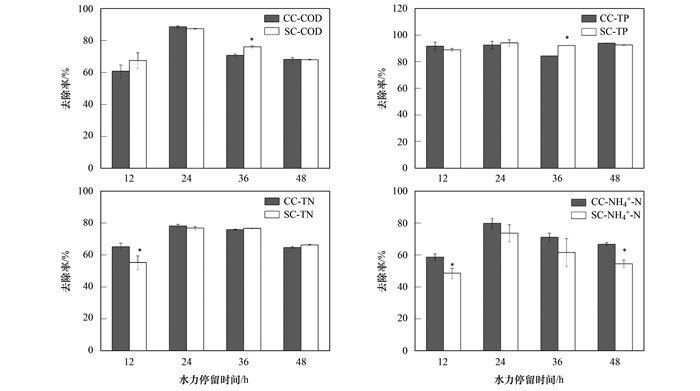
|
*表示两种湿地类型对常规污染物去除率显著性P<0.05 图 2 不同水力停留时间下潜流湿地常规污染物去除率 Fig. 2 Removal rate of conventional pollutants in subsurface flow wetlands with different hydraulic residence times |
在湿地系统中, COD主要通过微生物缺氧和好氧代谢过程被分解去除或利用[16], 而TP的去除主要依赖于填料的吸附和沉淀[17].本研究中, COD和TP的去除效果随着水力停留时间的延长先升高后降低, 当水力停留时间为24 h时, 两种湿地对COD和TP的去除率最高(垂直潜流人工湿地为88.50%和92.49%; 水平潜流人工湿地为87.15%和94.01%).当水力停留时间过短时, 污水中的COD还未来得及被系统充分降解或吸附, 而当水力停留时间过长时, 容易造成系统内部缺氧状态, 并且基质中微生物长时间处于贫营养状态, 从而削弱了微生物活性, 导致去除率下降[18]; 由于基质的吸附沉淀是去除磷的主要途径, 基质内含的活性铁离子和交换性铝离子可短时间快速吸附除磷, 当吸附位点饱和时, 吸附作用不再发生, 因此去除率也就不会随着水力停留时间的延长而提高[19].
与COD和TP一样, 不同水力停留时间下, TN和NH4+-N去除效果有明显的差异.当水力停留时间为24 h时, 脱氮效果最佳, 其中垂直潜流人工湿地对TN和NH4+-N的去除率分别为78.03%和79.71%; 水平潜流人工湿地分别为76.70%和73.50%.在一定的水力停留时间范围内, 随着时间的延长, 氮的去除率明显增高[20]; 但是当停留时间过长时, 系统内部有机物含量降低, 并且基质将处于严重的缺氧状态, 抑制了硝化作用[21], 此时反硝化作用的底物浓度降低, 且反硝化过程所需碳源不足, 从而导致湿地系统对TN和NH4+-N的去除率明显降低.
2.2 两种人工湿地各基质层总氮和氨氮的去除率以及硝化和反硝化速率由图 3可知, 垂直潜流人工湿地NH4+-N和TN的去除率以及硝化和反硝化强度表现出沿重力方向逐级递减的趋势.其中, 土壤层对NH4+-N和TN的去除率范围分别为74.64%~77.26%和60.54%~64.09%, 基质层两端硝化作用和反硝化作用最强, 可达0.697 μg·(g·h)-1和1.960 μg·(g·h)-1.水平潜流人工湿地内部各基质层NH4+-N和TN的去除率以及硝化和反硝化强度均表现出进水端大于出水端, 其中进水端对NH4+-N和TN的去除率范围分别为56.82%~71.09%和54.79%~61.42%, 硝化和反硝化作用强度范围分别为:0.328~0.692 μg·(g·h)-1和0.738~0.853 μg·(g·h)-1.有研究表明, 硝化-反硝化作用与碳源、TN和TP含量呈显著正相关[22, 23].在本研究中, 垂直潜流人工湿地土壤层以及水平潜流人工湿地进水端因具有充足的营养源, 为硝化和反硝化作用的发生提供了有利的条件, 从而导致硝化和反硝化作用最强, NH4+-N和TN的去除效果最好.
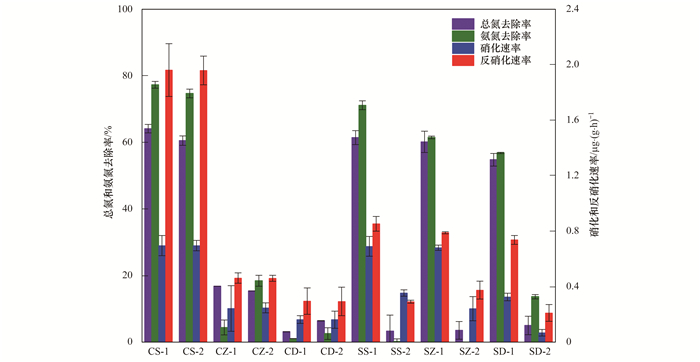
|
图 3 各基质层总氮和氨氮去除率以及硝化和反硝化速率 Fig. 3 Total nitrogen (TN) and ammonia nitrogen (NH4+-N) removal rates, as well as nitrification and denitrification rates of each substrate layer |
由图 4可知, 除垂直潜流人工湿地CS-1采样点nirS和AOB-amoA数量较多, 分别为2.23×108平均拷贝数·g-1和9.24×105平均拷贝数·g-1(以基质计), 两种湿地各基质层nirS和AOB-amoA数量波动范围较小.相较于nirS和AOB-amoA而言, nxrA数量相对较少.并且, 垂直潜流和水平潜流两种人工湿地内部nxrA数量变化趋势均表现土壤层远高于生物陶粒层和砾石层.
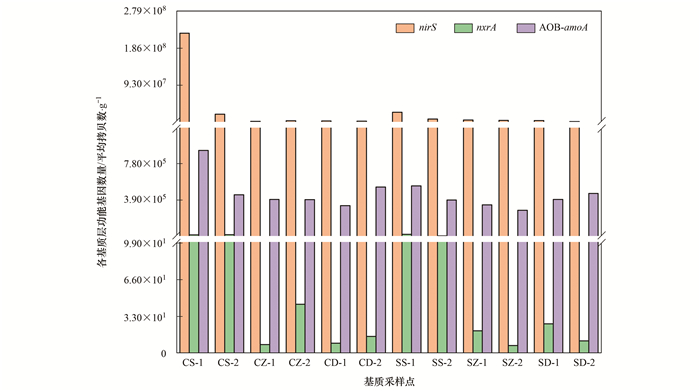
|
图 4 各基质层功能基因数量 Fig. 4 Number of functional genes in each stroma layer |
溶解氧(DO)是脱氮功能基因数量的限制因素之一[24], 在本研究中垂直潜流人工湿地土壤层DO变化范围为:6.30~6.81 mg·L-1, 生物陶粒层DO变化范围为:5.50~5.90 mg·L-1, 砾石层DO变化范围为:4.70~5.15 mg·L-1; 水平潜流人工湿地土壤层DO变化范围为:3.84~5.75 mg·L-1, 生物陶粒层DO变化范围为:2.50~4.20 mg·L-1, 砾石层DO变化范围为:2.21~3.31 mg·L-1.携带nirS的反硝化细菌为兼性厌氧菌, 通常, 氧的存在会抑制其活性[25].值得注意的是, 尽管两种湿地土壤层DO处于较高水平, 然而该基质层反硝化功能基因数量却不低于陶粒层和砾石层, 甚至部分区域(CS-1)远高于陶粒层和砾石层.Wu等[26]的研究表明, 由于反硝化细菌大多为异养, 植物根系分泌物中含有的低分子量有机酸、糖、氨基酸和次级代谢产物可以为其提供碳源, 促进反硝化菌繁殖和活性提高[27].结合两种湿地植物根系分布情况发现, 土壤层植物根系发达, 该基质层根系分泌物如蔗糖等含量相对偏高.因此, 在本研究中土壤层nirS数量偏高, 推测其原因可能是土壤层中植物根系影响了根际周围碳源含量, 从而导致携带有nirS的反硝化细菌群落结构发生变化.
Randall等[28]的研究认为当DO高于2 mg·L-1时, 系统中的微生物可进行正常的硝化反应.因此, 在本研究中, 各基质层的硝化细菌活性均未受到抑制.随着基质层深度的提高, 溶解氧含量逐渐降低, nxrA数量也呈现出逐渐降低的趋势, 这与贺峰等[15]的研究结论接近.
2.4 两种人工湿地环境因子、TN和NH4+-N的去除率与氮去除功能基因之间的关系为了进一步确定潜流人工湿地内部氮去除机制, 本研究将3种环境因子[DO、基质比表面积(BB)、pH]、3种功能基因(nxrA、nirS、AOB-amoA)和3种污染物去除率(TN、NH4+-N、COD)进行冗余分析和方差分解分析.
由图 5和图 6可知, 垂直潜流人工湿地RDA图第一轴和第二轴可解释累计高达98.56%的变异; 水平潜流人工湿地RDA图第一轴和第二轴可解释累计94.27%的变异.因此, 均可选用第一轴和第二轴进行可视化.结果显示, 在垂直潜流人工湿地中DO、pH和COD这3个因子的箭头较长, 说明基质层内DO、COD和pH是影响nxrA、nirS和AOB-amoA的主要因子; 其中DO和COD与nxrA和nirS呈正相关, 而pH与这两种功能基因呈负相关关系.在水平潜流人工湿地中除DO、COD和pH外, BB也是影响功能基因的主要环境因子; 其中DO与nxrA呈正相关关系, BB和COD与nirS呈正相关关系, 而pH与两种功能基因均呈负相关关系.
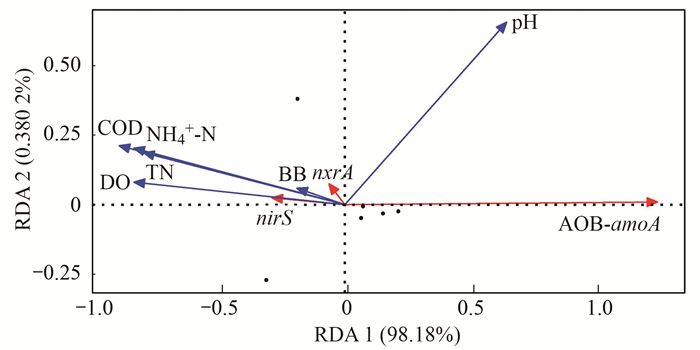
|
图 5 垂直潜流人工湿地RDA约束排序分析 Fig. 5 Biplot of RDA constraint sequencing analysis of vertical subsurface flow constructed wetlands |
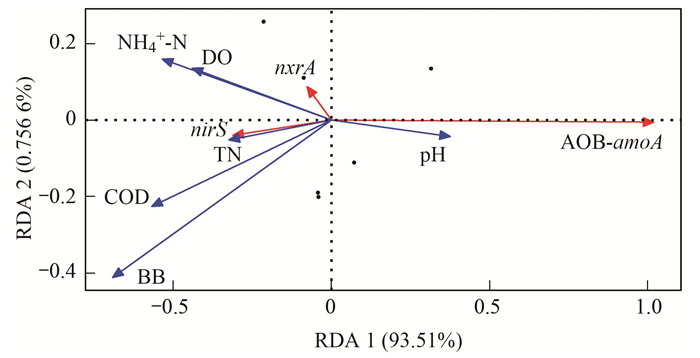
|
图 6 水平潜流人工湿地RDA约束排序分析 Fig. 6 Biplot of RDA constraint sequencing analysis of horizontal subsurface flow constructed wetlands |
有研究表明, 湿地基质类型、溶解氧、pH和COD在人工湿地氮去除过程中发挥着重要效应[13].当湿地基质具有较大的比表面积时, 可以为微生物提供更大的附着面积并且对氮的吸附效果也相应提高[29]; 当湿地内部DO偏低或pH值偏大, 硝化过程将会受到抑制, 从而影响反硝化作用强度[30, 31]; 而各基质层COD浓度偏低时, 微生物可利用碳源含量受到限制, 微生物没有充足的营养源, 其活性降低, 导致湿地脱氮效果不佳[32].
在本研究中, 垂直潜流人工湿地TN和NH4+-N的去除率主要与DO、BB、COD、nxrA和nirS呈正相关.水平潜流人工湿地NH4+-N的去除率主要与DO和nxrA呈正相关; TN去除率主要与DO、BB、COD、nxrA和nirS呈正相关.此外, 两种潜流型人工湿地TN和NH4+的去除率与pH均成反比.
为了对两种潜流湿地脱氮效果影响因素做进一步识别, 根据冗余分析结果, 提取出两种潜流湿地脱氮效果的影响因素对其进行方差分解分析.由图 7可知, 在垂直潜流人工湿地中系统内参与氮转化的功能基因对脱氮的贡献率为55%, 其次是环境因素(32%), 微生物和环境因素的相互作用占(4%), 其他因素占9%; 水平潜流人工湿地系统中微生物对脱氮贡献率为48%, 环境因素占19%, 其他因素占35%.

|
图 7 两种潜流人工湿地VPA结果示意 Fig. 7 Diagram of VPA results for two subsurface flow constructed wetlands |
明确人工湿地系统氮转化影响因素以及定量地分析各因素贡献率, 对于人工湿地设计和改善十分有意义.通过两种湿地冗余分析和方差分解分析发现, 垂直潜流和水平潜流人工湿地都可以通过人工曝气和增加碳源含量来提高系统内部溶解氧和COD浓度以及适当地降低pH值从而促进微生物的硝化-反硝化强度.除此之外, 相较于垂直潜流人工湿地, 水平潜流人工湿地系统中基质比表面积对脱氮效果影响更加显著, 因此水平潜流人工湿地还可通过增加土壤层或生物陶粒层厚度来提高系统的脱氮能力.
3 结论(1) 当水力停留时间为24 h时, 两种类型人工湿地对常规污染物(COD、TP、TN和NH4+-N)去除效果最佳.此时, 系统内部对NH4+-N和TN的去除率以及硝化和反硝化强度皆表现出沿水流方向逐级递减趋势; 各基质层中nxrA数量明显低于nirS和AOB-amoA.
(2) 冗余分析结果表明, 垂直潜流人工湿地参与氮转化的3种功能基因主要受溶解氧(DO)、pH和COD影响, 而水平潜流人工湿地除溶解氧(DO)、pH和COD外, 基质比表面积(BB)也是影响功能基因丰度的主要环境因素.
(3) 冗余分析结合方差分解分析结果表明, 垂直和水平潜流湿地系统氮去除效果均主要受微生物因素影响(分别为55%和48%), 其次是环境因素(32%和19%).
| [1] |
蒋倩文, 刘锋, 彭英湘, 等. 生态工程综合治理系统对农业小流域氮磷污染的治理效应[J]. 环境科学, 2019, 40(5): 2194-2201. Jiang Q W, Liu F, Peng Y X, et al. Nitrogen and phosphorus removal by integrated ecological engineering treatment system in a small agricultural watershed[J]. Environmental Science, 2019, 40(5): 2194-2201. |
| [2] |
廖雪珂, 严晗璐, 王智源, 等. 低温季节水平潜流和垂直潜流人工湿地尾水深度处理中试[J]. 环境科学, 2020, 41(12): 5509-5517. Liao X K, Yan H L, Wang Z Y, et al. Advanced treatment of tail water using pilot-scale horizontal and vertical subsurface flow constructed wetlands in low-temperature seasons[J]. Environmental Science, 2020, 41(12): 5509-5517. |
| [3] |
丁怡, 王玮, 宋新山, 等. 人工湿地在水质净化中的应用及研究进展[J]. 工业水处理, 2014, 37(3): 6-10. Ding Y, Wang W, Song X S, et al. Application of constructed wetland to water purification and its research progress[J]. Industrial Water Treatment, 2014, 37(3): 6-10. DOI:10.3969/j.issn.1005-829X.2014.03.002 |
| [4] |
丁怡, 唐海燕, 刘兴坡, 等. 不同类型人工湿地在污水脱氮中的研究进展[J]. 工业水处理, 2019, 39(7): 1-3, 9. Ding Y, Tang H Y, Liu X P, et al. Research progress in different kinds of constructed wetlands for nitrogen removal from wastewater[J]. Industrial Water Treatment, 2019, 39(7): 1-3, 9. |
| [5] |
王迪, 李红芳, 刘锋, 等. 亚热带农区生态沟渠对农业径流中氮素迁移拦截效应研究[J]. 环境科学, 2016, 37(5): 1717-1723. Wang D, Li H F, Liu F, et al. Interception effect of ecological ditch on nitrogen transport in agricultural runoff in subtropical China[J]. Environmental Science, 2016, 37(5): 1717-1723. |
| [6] |
徐丽, 葛大兵, 谢小魁. 水力停留时间对人工湿地运行的影响[J]. 中国农学通报, 2014, 30(31): 219-223. Xu L, Ge D B, Xie X K. Impact of hydraulic retention time on wetland running[J]. Chinese Agricultural Science Bulletin, 2014, 30(31): 219-223. DOI:10.11924/j.issn.1000-6850.2014-0621 |
| [7] |
熊佐芳, 周云新, 冼萍, 等. 水力负荷对垂直流人工湿地堵塞影响研究[J]. 水处理技术, 2011, 37(7): 34-36, 44. Xiong Z F, Zhou Y X, Xian P, et al. The study for the influence of hydraulic load on clogging of the vertical-flow constructed wetland[J]. Technology of Water Treatment, 2011, 37(7): 34-36, 44. |
| [8] |
裴亮, 孙莉英, 梁晶, 等. 不同填料对阶梯式人工湿地降解农业废水的影响[J]. 水资源与水工程学报, 2018, 29(1): 232-235, 241. Pei L, Sun L Y, Liang J, et al. Effect of different matrix in steps constructed wetland system for degradation of agricultural waste water[J]. Journal of Water Resources and Water Engineering, 2018, 29(1): 232-235, 241. |
| [9] |
王世和, 王薇, 俞燕. 水力条件对人工湿地处理效果的影响[J]. 东南大学学报(自然科学版), 2003, 33(3): 359-362. Wang S H, Wang W, Yu Y. Influence of hydraulic condition on treatment effect of constructed wetland[J]. Journal of Southeast University (Natural Science Edition), 2003, 33(3): 359-362. DOI:10.3321/j.issn:1001-0505.2003.03.028 |
| [10] | Gale P M, Redely K R, Graetz D A. Nitrogen removal from reclaimed water applied to constructed and natural wetland microcosms[J]. Water Environment Research, 1993, 65(2): 162-168. DOI:10.2175/WER.65.2.9 |
| [11] | Krishnani K K. Detection and diversity of nitrifying and denitrifying functional genes in coastal aquaculture[J]. Aquaculture, 2010, 302(1-2): 57-70. DOI:10.1016/j.aquaculture.2010.01.024 |
| [12] | Philippot L. Denitrifying genes in bacterial and archaeal genomes[J]. Biochimica et Biophysica Acta (BBA)-Gene Structure and Expression, 2002, 1577(3): 355-376. DOI:10.1016/S0167-4781(02)00420-7 |
| [13] |
李旭东, 张旭, 薛玉, 等. 沸石芦苇床除氮中试研究[J]. 环境科学, 2003, 24(3): 158-160. Li X D, Zhang X, Xue Y, et al. Nitrogen removal in a pilot-scale zeolite reed bed system[J]. Environmental Science, 2003, 24(3): 158-160. DOI:10.3321/j.issn:0250-3301.2003.03.032 |
| [14] | 国家环境保护总局. 水和废水监测分析方法[M]. (第四版). 北京: 中国环境科学出版社, 2002. |
| [15] |
贺锋, 吴振斌, 陶菁, 等. 复合垂直流人工湿地污水处理系统硝化与反硝化作用[J]. 环境科学, 2005, 26(1): 47-50. He F, Wu Z B, Tao J, et al. Nitrification and denitrification in the integrated vertical flow constructed wetlands[J]. Environmental Science, 2005, 26(1): 47-50. |
| [16] |
庞长泷. 组合型潜流人工湿地净化效能及微生物强化作用分析[D]. 哈尔滨: 哈尔滨工业大学, 2016. Pang C L. Removal efficiency and microbial bioaugmentation analysis of the hybrid subsurface flow constructed wetland systems[D]. Harbin: Harbin Institute of Technology, 2016. |
| [17] | Vymazal J, Kröpfelová L. Multistage hybrid constructed wetland for enhanced removal of nitrogen[J]. Ecological Engineering, 2015, 84: 202-208. DOI:10.1016/j.ecoleng.2015.09.017 |
| [18] |
张弘弢, 谌书, 王彬, 等. 组合式人工湿地对分散型生活污水净化效果及其微生物群落结构特征[J]. 环境化学, 2019, 38(11): 2535-2545. Zhang H T, Chen S, Wang B, et al. Purification effect of combined artificial wetlands on dispersed domestic sewage and analysis of microbial community structure[J]. Environmental Chemistry, 2019, 38(11): 2535-2545. |
| [19] |
张毓媛, 曹晨亮, 任丽君, 等. 不同基质组合及水力停留时间下垂直流人工湿地的除污效果[J]. 生态环境学报, 2016, 25(2): 292-299. Zhang Y Y, Cao C L, Ren L J, et al. Research on pollutants removal effect of different combined substrate under different hydraulic retention time in vertical flow constructed wetlands[J]. Ecology and Environmental Sciences, 2016, 25(2): 292-299. |
| [20] | Apel E C, Riemer D D, Hills A, et al. Measurement and interpretation of isoprene fluxes and isoprene, methacrolein, and methyl vinyl ketone mixing ratios at the prophet site during the 1998 Intensive[J]. Journal of Geophysical Research, 2002, 107(D3). DOI:10.1029/2000JD000225 |
| [21] | Ho K F, Lee S C, Louie P K K, et al. Seasonal variation of carbonyl compound concentrations in urban area of Hong Kong[J]. Atmospheric Environment, 2002, 36(8): 1259-1265. DOI:10.1016/S1352-2310(01)00570-2 |
| [22] | Burgin A J, Groffman P M, Lewis D N. Factors regulating denitrification in a riparian wetland[J]. Soil Science Society of America Journal, 2010, 74(5): 1826-1833. DOI:10.2136/sssaj2009.0463 |
| [23] |
孙志高, 刘景双. 湿地土壤的硝化-反硝化作用及影响因素[J]. 土壤通报, 2008, 39(6): 1462-1467. Sun Z G, Liu J S. Nitrification-denitrification and its affecting factors in wetland soil—A review[J]. Chinese Journal of Soil Science, 2008, 39(6): 1462-1467. DOI:10.3321/j.issn:0564-3945.2008.06.049 |
| [24] | Austin D, Nivala J. Energy requirements for nitrification and biological nitrogen removal in engineered wetlands[J]. Ecological Engineering, 2009, 35(2): 184-192. DOI:10.1016/j.ecoleng.2008.03.002 |
| [25] | Coban O, Kuschk P, Kappelmeyer U, et al. Nitrogen transforming community in a horizontal subsurface-flow constructed wetland[J]. Water Research, 2015, 74: 203-212. DOI:10.1016/j.watres.2015.02.018 |
| [26] | Wu H L, Wang X Z, He X J, et al. Effects of root exudates on denitrifier gene abundance, community structure and activity in a micro-polluted constructed wetland[J]. Science of the Total Environment, 2017, 598: 697-703. DOI:10.1016/j.scitotenv.2017.04.150 |
| [27] | Coskun D, Britto D T, Shi W M, et al. How plant root exudates shape the nitrogen cycle[J]. Trends in Plant Science, 2017, 22(8): 661-673. DOI:10.1016/j.tplants.2017.05.004 |
| [28] | Randall C W, Buth D. Nitrite build-up in activated sludge resulting from temperature effects[J]. Journal (Water Pollution Control Federation), 1984, 56(9): 1039-1044. |
| [29] |
黄逸群, 张民, 徐玉新. 人工湿地填料净化生活污水级配优化研究[J]. 环境科学与技术, 2009, 32(3): 130-134, 138. Huang Y Q, Zhang M, Xu Y X. Optimizing substrate gradation for constructed wetland treating domestic wastewater[J]. Environmental Science & Technology, 2009, 32(3): 130-134, 138. DOI:10.3969/j.issn.1003-6504.2009.03.032 |
| [30] | Groeneweg J, Sellner B, Tappe W. Ammonia oxidation in nitrosomonas at NH3 concentrations near km: effects of pH and temperature[J]. Water Research, 1994, 28(12): 2561-2566. DOI:10.1016/0043-1354(94)90074-4 |
| [31] | Kearney M A, Zhu W X, Graney J. Inorganic nitrogen dynamics in an urban constructed wetland under base-flow and storm-flow conditions[J]. Ecological Engineering, 2013, 60: 183-191. DOI:10.1016/j.ecoleng.2013.07.038 |
| [32] |
吕涛, 吴树彪, 柳明慧, 等. 潮汐流及水平潜流人工湿地污水处理效果比较研究[J]. 农业环境科学学报, 2013, 32(8): 1618-1624. Lv T, Wu S B, Liu M H, et al. Comparison of purification performance in tidal flow and horizontal subsurface flow constructed wetland[J]. Journal of Agro-Environment Science, 2013, 32(8): 1618-1624. |
 2021, Vol. 42
2021, Vol. 42


